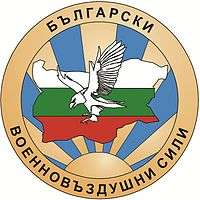Bulgarian Air Force
| Bulgarian Air Force | |
|---|---|
|
Logo of the Bulgarian Air Force | |
| Active | 1906–present |
| Country |
|
| Allegiance | NATO |
| Type | Air force |
| Role | Defence of Bulgarian air space |
| Size |
100 aircraft 6,500 active duty personnel |
| Anniversaries | 16th October |
| Website | http://airforce.mod.bg/bg/ |
| Commanders | |
| Commander | Major General Tsanko Stoychev |
| Vice Commander | Brigadier General Anatoliy Krustev |
| Insignia | |
| Roundel |
 |
| Aircraft flown | |
| Attack | Su-25, Mi-24 |
| Fighter | MiG-29 |
| Helicopter | Mi-17, Mi-24, Eurocopter AS 532 Cougar, Bell 206 |
| Reconnaissance | An-30 |
| Trainer | L-39, PC-9 |
| Transport | L-410, C-27J Spartan, Pilatus PC-12, Airbus A319, Dassault Falcon 2000 |
The Bulgarian Air Force (Bulgarian: Военновъздушни сили, ВВС) is one of the three branches of the Military of Bulgaria, the other two being the Bulgarian Navy and Bulgarian land forces. Its mission is to guard and protect the sovereignty of Bulgarian airspace, to provide aerial support and to assist the Land Forces in case of war. The Bulgarian Air Force is one of the oldest air forces in Europe and the world. In recent times it has been actively taking part in numerous NATO missions and exercises in Europe. The current commanding officer of the Bulgarian Air Force is Major General Constantin Popov.
History
Early years
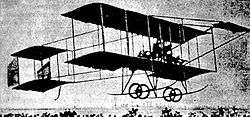
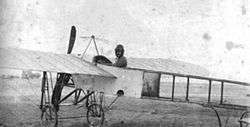
The history of the Bulgarian Air Force can be traced back to the end of the 19th century, when in 1892 at the Plovdiv International Fair two lieutenants of the Bulgarian Army flew in the ‘La France’ balloon of the Frenchman Godard.[1] Later, inspired by the flight, they succeeded to convince the General Staff that the Bulgarian Army should build a balloon force. The Imperial Aviation School in St. Petersburg enrolled Lieutenant Vasil Zlatarov as a student, following numerous refusals from military schools around Europe to teach Bulgarian officers to use airships. On 20 April 1906 "Vazduhoplavatelno Otdelenie" (roughly translated as Aviation Squad) was created to operate observation balloons for the army, initially being a part of Railway Battalion.[1] After graduation Lt. Zlatarov was appointed its first commander. After operating small balloons, in 1911 a bigger Godard balloon was bought, and in 1912 the first balloon Sofia-1 was constructed in Bulgaria, of materials bought from Russia.[1]
In 1910 a Russian aircraft engineer, Boris Maslennikov, was invited to Bulgaria, where he presented his airplane, a modification of the French Farman III. Following his demonstration, assisted by Vasil Zlatarov over the hippodrome in Sofia, the Bulgarian Government decided to acquire airplanes for The Aviation Corps. In early 1912 thirteen army officers were sent abroad for training as pilots and orders were placed for five French, British and German airplanes.[1] The officers sent to France completed their training first and returned to Bulgaria in July 1912. The same year Bulgaria received its first airplane – Bleriot XXI with which on 13 August 1912 Simeon Petrov flew to become the first Bulgarian to pilot an airplane over Bulgaria.[1]
First and Second Balkan Wars

Following the outbreak of the First Balkan War, Bulgarian pilots still abroad hastily procured aircraft to be shipped home after them and foreign volunteer pilots converged from all over Europe in Bulgaria. After the front lines had stabilized, an Aeroplane Platoon was established at a new airfield close to the fighting.
Intelligence about the Turkish army strength and dispositions in the Odrin(Adrianople) keep was required, and on 16 October 1912, two aviators performed a reconnaissance flight over the city in an Albatros FIII biplane, dropping also two bombs, which was not only the first military mission performed by a Bulgarian aircraft, but also the first combat use of an aircraft in Europe.[1]
Later that month the Bulgarian Aviation Corps was expanded to three Aeroplane Platoons. Foreign volunteers began flying operational sorties alongside Bulgarian pilots and carried out reconnaissance, leaflet-dropping and bombing missions. During the war at least three aircraft were shot down. Considerable help was received from the Russians in terms of aircraft, maintenance and training. Due to low aircraft serviceability and frequent accidents, the number of missions flown was relatively low. Despite that, the Bulgarian airmen and their foreign helpers were able to gather enough intelligence for the Army General Staff to use in the capture of the city. Although inflicting little physical damage, the bombs had a devastating effect on the defending Turkish garrison's morale and played a crucial part in the fall of the city, which was until then considered nearly impregnable. During the First Balkan War Bulgarian aviation undertook 70 combat sorties, including 11 bombing raids, during the Second Balkan War it undertook 6 sorties.[1] All in all, during both wars, there were over 230 aircraft sorties, including non-combat.[1] The aircraft used were Blériot XI and XXI, Voisin, Sommer, Albatros FIII, Bristol, Farman VII and Nieuport IV.[1]
World War I (1914–1918)

Army air action
The Kingdom of Bulgaria entered World War I as an ally of the Central Powers on October 4, 1915. The Aeroplane Section of the Bulgarian Army was deployed to Kumanovo Airfield in support of advancing Bulgarian forces, but bad weather initially prevented any flying. Until then they had completed 11 combat sorties from an airfield in Sofia (now the central railway station). As the frontline advanced, the unit re-deployed to airfields near Belitsa and Xanthi, in modern Greece). Newly acquired German LVG aircraft were hastily pressed into action. Two more airfields were constructed near Udovo and Levunovo. The Allies began flying reconnaissance and bomber sorties against Bulgarian units on the Southern Balkan Front. Throughout World War I Bulgarian military aviation experienced a steady increase in both numbers and quality of aircraft; however, they remained inferior to those flown by the Allies, especially the British and French. The First Aeroplane Section (the country's only aircraft unit) was attached to the Second Bulgarian Army. It flew 255 sorties compared to 397 flown by the four squadrons of the Entente it opposed, and operated the following types:
- 12 LVG B.II – reconnaissance aircraft, the first group of six arriving in November 1915. Those two seaters were also used as fighters by the Bulgarians, as dedicated "scouts" were not available.
- 13 Otto C.I – a twin-tailed pusher bomber. The first Otto in arrived in May 1916.
- 18 Albatros C.III – reconnaissance aircraft, also used as trainers. First delivery in August 1916.
- 12 DFW C.V – reconnaissance aircraft, first arriving in August 1917.
- 6 Roland D.II fighters. During July 1917 the first of these arrived with the Section.
- 6 Roland D.III fighters, the first arriving at the end of 1917.
- 3 Fokker E.III fighters, first of these delivered in the spring of 1916.
- 8 Fokker D.VII – the best fighter used by Bulgaria in World War I. Delivery took place in September 1918 and they saw no action. 7 were scrapped in accordance with the peace treaty. The 8th flew as a two-seater after the war.
- 2 Albatros C.I. These were ordered by the Ottoman Empire before Bulgaria entered the war. During early 1915 a couple landed on then neutral Bulgarian territory after a navigational error, and they were seized.
In addition, the Bulgarian Navy used the following airplanes:
- 8 Friedrichshafen FF-33 floatplane bombers, starting in 1916
- 2 Rumpler 6B1 floatplane fighters, starting in 1916
A number of Bulgarian pilots flew with German air units at the Western Front and at Xanthi. They operated several types, including the Albatros D.III and Halberstadt, which would later mistakenly be listed on the Bulgarian inventory by some sources.
Captured Allied aircraft
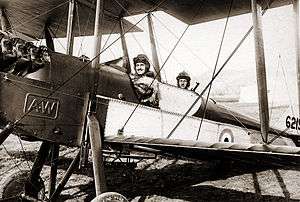
On 30 September 1916 a French Farman F.40 bomber of Escadrille 384 was tasked with attacking the Bulgarian capital, Sofia. Two Bulgarian Fokker E.IIIs were positioned south of Sofia to intercept the intruder, while a flight of three armed Albatros C.III two-seat trainers covered the center of the city as backup. The bomber successfully dropped its bombs over Sofia while escaping anti-aircraft fire but, while departing, was attacked by the Bulgarian Fokkers which brought the Farman down with a dead engine.
Another Allied aircraft, a British Armstrong Whitworth F.K.3, was captured by Bulgarian troops on 12 February 1917 after engine problems forced it to land. Both it and the crew were captured. It would receive Bulgarian insignia and be used to bomb Allied positions at night. Four such sorties were flown before being shot down on 23 May 1918.
A Nieuport 24bis and a Nieuport 27 were also captured. Lieutenant Vladimir Balan, a Bulgarian fighter pilot who had been flying with a German Jasta on the Western Front, was flying one of the Nieuports when he shot down the squadron leader of No. 17 Squadron RAF.
Naval air action
Bulgarian naval aviators also played an important role in the air war. In 1912 Petty-Officers Lyapchev and Mikhailov were sent, along with other officers and seamen, to the German naval aviation forming facilities for training. Another group of naval personnel followed in the beginning of the First World War. Training was held at List, Nordenhai and Kiel. In November 1915 a seaplane station under German control was established near Varna, initially operating four Friedrichshafen FF-33 bombers and a Rumpler 6B1 fighter. Later, at the coast of the Varna Lake, a second seaplane station was built (this one under Bulgarian control), operating the same inventory. Near Sozopol a forward fuel and ammunition replenishment base was established in support of patrol flights over the southern Bulgarian coastline. At the end of 1917 the German station was transferred to the Bulgarian Navy. At the time of the armistice the Bulgarian fleet air arm comprised two seaplane stations, a forward replenishment base, three hangars, three workshops, ammunition warehouses and 10 seaplanes. After the cease-fire the machines were used for mine reconnaissance. At the end of 1919 they are transported by train to Bozhurishte Airfield to be scrapped along with the army aviation inventory.
The Bulgarian balloon observers also took part in the war. They were most active on the Dobrudzha Front, where aircraft activities were scarce (a German bomber squadron, flying missions against Bucharest and Constanţaine: "Gotha" bombers accounted for the most flights). Near the Bulgarian city of Yambol an airship hangar was constructed to house German airships. The airship Schütte-Lanz SL 10 was the first to use it. According to documents of the time it was assigned to the Bulgarian Army, but was actually under German control. It was lost during a flight over the Black Sea in July 1916. In August 1916 the LZ 101 replaced it. After performing raids on targets in Romania and Greece it returned to Germany in August 1917. In November 1917 the naval airship L 59 arrived. That airship flew a series of remarkable missions, such as an attempted resupply of the garrison in the colony German East Africa and the bombing of Naples and Port Said. During a mission against the British naval base in Malta, a lightning strike over the Mediterranean Sea set it alight and completely destroyed it. All hands were lost.[2]
Destruction and survival under the peace treaty (1919–1936)
On the 4 October 1918 the Bulgarian Tsar issued a Royal Act of Demobilization. This resulted in military aviation being converted to its peace-time structure. The Aeroplane group, based in Bozhurishte comprised the following:
- Two aeroplane companies
- An aeroplane school
- An aeroplane atelliér
- An aeroplane depot
The Chaika Naval Seaplane station at Varna was under Naval command.
On November 27, 1919 the Treaty of Neuilly-sur-Seine was signed. In accordance with the treaty the Kingdom of Bulgaria was banned from operating military aircraft under any form for the next 20 years. For that reason all Bulgarian airplanes, balloons, aviation equipment, weaponry and ammunition were to be destroyed under Allied control. Under the terms of the treaty any aircraft procured for civilian purposes had to be bought from the countries on the winning side. The combined engine power for any airplane (including multi-engined ones) was not to exceed 180 hp. In addition, the Bulgarian airspace was to be controlled by the allies and used according to the victorious countries' interests.
In accordance with the treaty during 1920 no less than 70 airplanes, 110 aviation engines, 3 air balloons, 76 aviation machine guns, a number of photographic cameras and other aviation equipment were destroyed at the military airfield of Bozhurishte. The seaplanes of the Bulgarian Navy were delivered by train to the same airfield and scrapped soon after that.

Due to the devotion of the Air Troops personnel and the help of the population of the surrounding villages, several aircraft were hidden, thus evading Allied inspection following destruction. Seven DFW C.V, Albatros C.III and a single Fokker D.VII were among the survivors. In addition, at least ten aviation engines (Benz-IV and Mercedes-III) were also saved.
The Bulgarian government tried to get around the ban for military flight activity by establishing a Gendarmery Aeroplane Section in 1919. Since the Gendarmery was at that time a service under the Ministry of War, the creation of the unit was met by fierce opposition by the Allied commission. This almost resulted in the destruction of the whole Vrazhdebna Airfield, but the disbandment of the unit prevented this from happening.
An Aeroflight Section under the Ministry of Railways, Postal Service and Telegraph was created in 1920. Bulgarian aviation personnel assembled two airplanes from hidden spares and parts, salvaged from the destroyed military airplanes. The two aircraft, known as "the mixed planes", recorded about 1000 flight hours altogether. The sole remaining Bulgarian Fokker D.VII was disguised as a two-seater, thus being classified as a trainer and returning to active service.
On 5 July 1923 Bulgaria ratified the International Civil Aviation Treaty. From that moment on its air vehicles would carry a registration in the form B-B??? (the latter three signs being a combination of capital letters). In 1923 the first group of cadets, called "student-flyers" entered the Flying school at Vrazhdebna AF.
The following year (1924) the first new airplanes were acquired. Those were machines of the Potez VIII, Caudron C.59, Henriot XD.14, Bristol 29 Tourer types; Avro 522 seaplanes were also procured. During the same year the Bulgarian airplane construction specialist Atanas Grigorov (who obtained his qualification at the "Albatroswerke – Berlin") assembled his seaplane, called "Grigorov-1". The aircraft made several test-flights, recording excellent characteristics, but was damaged beyond repair by a storm in the hangar where it was stationed. Also in 1924 the Aeroplane Section was expanded to an Aeroflight Directorate still under the Ministry of Railways, Postal Service and Telegraph.
1925 saw the Potez XVII, Bristol Lucifer and the Macchi 2000/18 flying boats boosting the country's aircraft inventory. The Bulgarian government invited a group of German aircraft engineers, headed by the constructor Herr Hermann Winter to help establish an aviation factory. Named The State's Aeroconstruction Atelliér (more popular as DAR-Bozhurishte) the factory was initially managed by the first Bulgarian pilot to achieve an aerial victory – Mr. Marko Parvanov. The first aircraft types, produced by the plant were the "Uzounov-1" (an indigenous variant of the wartime German DFW C.V) and the DAR-2 (indigenous variant of the German Albatros C.III of the same era). Both types well-known and loved by the personnel of the former Air Troops and with Bulgarian combat service experience. A new type – the DAR-1 – was also in a phase of development.
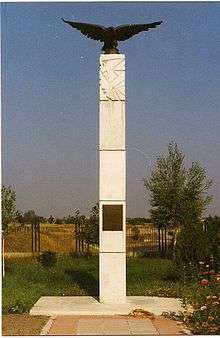

During the course of 1926 the Airplane School was moved to the geographical center of the country. The town of Kazanlak was well suited, for it stayed away from the Allied Control Commission. The Czechoslovak "AERO-Praha" company also built an aircraft factory near that city, but its models were not up to the requirements of the Bulgarian authorities. After an unsuccessful switch to automotive production, the plant was finally sold to the Italian Caproni company. The factory became popular as "Balgarski Kaproni" or "Bulgarian Caproni". The first examples of the very successful DAR-1 were produced and entered service with the Aeroflight Directorate during 1926.
The 1927 structure of the Directorate was the following:
- A fighter yato,[NOTE 1] flying the DAR-1s
- A bomber yato, flying the DAR-"Uzounov-1" and DAR-2
- A recon yato, flying the Potez XVIIs
- A seaplane yato, flying the Avro 522 floatplanes and the Macchi 2000/18 flying boats
- An aeroplane school, flying the Caudron C-59, the Henriot XD.14 and the Šmolnik Š.18
In 1928 the Ministry of War started the ambitious 10-year program for development of the military aviation (still banned by the peace treaty). According to the plan the following structure had to be achieved:
- 4 army fighter orlyaks,[NOTE 2] each made of two yatos, or overall 8 yatos flying 96 fighter planes
- 4 army recon orlyaks, each made of two yatos, or overall 8 yatos flying 96 recon planes
- 18 divisionary recon yatos, basically air support aviation, each flying 12 planes or 216 planes altogether
- Strike Aviation Brigade with:
- Fighter Orlyak of 48 machines
- Bomber Orlyak of 36 machines
- Recon Orlyak of 2 machines
- Maritime Orlyak
- 2 seaplane fighter yatos, flying 24 fighters
- 2 seaplane bomber yatos, flying 18 bombers
In 1931 Bulgaria signed the Warsaw Treaty, concerning international civil air activities and the country was assigned the new civil registration – LZ-??? (the latter three signs being a combination of capital letters). In 1933 the Bulgarian Council of Ministers approved the following wartime order of battle of the aviation:

- a mixed orlyak of:
- a fighter yato
- a bomber yato
- a recon yato
- a liaison and photographic survey yato
- a maritime yato
- a training orlyak
- a Pilot School at Kazanlak airfield
- a balloon company (which was never actually created, as the balloon was considered obsolete for military purposes at the time).
Bulgaria started acquiring German, Czechoslovak and Polish airplanes.
In 1934 the Aviation Regiment was renamed His Majesty's Air Troops, comprising a headquarters, with two army orlyaks (based at Bozhurishte and Plovdiv airfields), a training orlyak (in Plovdiv), a maritime yato (at NAS Chaika, Varna) and additional operational support units. Chief of the HMAT became Colonel Ivan Mikhailov with Lieutenant-Colonel Georgi Vasilev appointed as his Deputy.[2]
Years of Rebirth (1937–1939)

The first combat aircraft that entered service in the reestablished air force in 1937 were 12 Arado Ar.65 fighters, 12 Heinkel He.51 fighters, 12 Dornier Do.11 bombers and 12 Heinkel He.45B recon planes. These machines are known as the Royal Gift, donated to the HMAT personally by King Boris III.
In 1937, during the traditional military parade of St. George's Day (National Day of Bravery and of the patron-saint of the Bulgarian Armed Forces), military aircraft officially debuted as a part of the armed forces after a nearly two-decade hiatus. A month later Boris III himself presented the Bulgarian air regiments with their new combat flags at an official ceremony at Vrazhdebna Airfield.
In 1937 14 PZL P.24B fighters and 12 PZL.43A light bombers were ordered from Poland, with deliveries starting later that year, while in 1938, orders were placed for 42 more PZL.43B light bombers and 12 PZL.24F fighters, which differed from the earlier aircraft in having more powerful engines.[3]
When the Third Reich occupied Czechoslovakia in 1938, the Czechoslovak air force was broken up. Bulgaria used the opportunity to acquire large numbers of relatively modern ex-Czech aircraft from the Germans at a bargain price. Bulgaria purchased 78 Avia B-534 biplane fighters, 32 Avia B.71 bombers (a license version of the Soviet SB bomber), 12 Bloch MB.200 bombers, 62 Letov Š-328 reconnaissance aircraft and 28 Avia Bs.122 trainers.[4] Deliveries of the second batch of Polish orders started in early 1939, with 33 PZL.43Bs and 8 PZL.11Fs delivered before the German invasion of Poland stopped deliveries (although two more PZL.43Bs were delivered by the Germans later.[5] In less than 3 years the Air Force inventory had grown up to 478 aircraft of which 135 were of Bulgarian construction.
World War II (1939–1945)


At the beginning of World War II, the combat air fleet comprised 374 machines in various roles. In addition orders were placed for 10 Messerschmitt Bf 109E-4 fighters, 11 Dornier Do 17M/P bombers, 6 Messerschmitt Bf 108 light liaison and utility aircraft, 24 Arado Ar 96B-2[6] and 14 Bücker-Bestmann Bü 131 trainers.
The Air Force order of battle comprised the 1st, 2nd, 3rd and 4th Army Aviation Orlyaks (Army Air Groups or air regiments), each attached to the correspondingly-numbered field army. Each orlyak had a fighter, a line bomber and two reconnaissance yatos (Squadrons). There was also an Independent Aviation corps, which combined the 5th Bomber and 6th Fighter Regiments. The training units consisted of the "Junker" School Orlyak at Vrazhdebna airfield, the 2nd Training Orlyak at Telish airfield (called the Blind Flying Training School) and the 3rd Training Orlyak at Stara Zagora airfield. In 1940, the Bulgarian aviation industry provided the HMAT with 42 DAR-9, 45 KB-5 aircraft and the serial production of the KB-6 – Bulgaria's first twin-engined aircraft was scheduled to commence. At year's end the Air Force had 595 aircraft (258 combat) and 10 287 personnel.
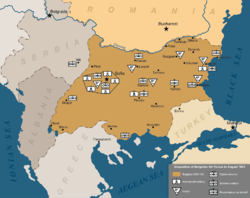
The Kingdom of Bulgaria signed the Tripartite Pact, becoming a formal ally of Germany.[6] Under the treaty, Bulgaria allowed the use of its territory as a staging point for the invasion of Yugoslavia and Greece and some minor logistical support.
Despite the impressive inventory, Bulgaria's fighter force at the time consisted of 91 machines, with just 10 of them being of the modern Bf 109E-4 type. Further 11 were of the outdated PZL.24B; the remaining numbers were of the Avia B.534 biplane types. The ground-based air defenses were made up of only 8 88 mm (3.5 in) and 6 20 mm (0.79 in) AA guns. To help its new ally the 12th Army of the Wehrmacht offered support with its air and air defense assets and 8 Freya-type radars dispersed throughout the country. A dispersed observation and reporting system was gradually developed.
The first air strike against Bulgarian targets was carried out by 4 Yugoslav Dornier Do.17Kb-1 on 6 April 1941 on the city of Kyustendil and its railway station killing 47 and injuring 95, mostly civilians. The air strikes intensified in the following days; British Royal Air Force units based in Greece participated in the attacks as well. At the end of April 2 and 5th Bulgarian armies occupied Greek and Yugoslav territories according to an agreement with the Third Reich. As a part of the joint armed forces' effort on June 26, 1941 6 Avia B.71 and 9 Dornier Do 17M bombers were transferred to the Badem Chiflik airfield near Kavala (in modern Greece). They were tasked with ASW patrols and air support for Italian shipping over the adjacent area of the Aegean Sea. In addition 9 Letov Š.328s based in Badem Chiflik provided the ground troops with air reconnaissance. At the Black Sea shores the "Galata" Fighter Orlyak was established at NAS Chaika, Varna, with the 10 Bf 109E-4s and 6 Avia B.534s. The S.328s were also used for ASW patrols over the Black Sea, flying out of the Sarafovo and Balchik airfields. At the end of 1941 the inventory of His Majesty's Air Troops consisted of 609 aircraft of 40 different types.
On 22 June 1941, Germany invaded the Soviet Union, but Bulgaria refused to take part, although it did declare war with Great Britain and the United States of America in December 1941. Bulgaria's inaction against the Soviet Union meant that supplies of German aircraft slowed to a trickle, with only four aircraft delivered from January to September 1942.[7]
Reestablishment under the Socialist government


The Bulgarian Air Force, along with other branches of the military, adopted the doctrine of the Soviet deep battle in its Cold War development. The force expanded rapidly with deliveries of different types of combat aircraft. The first shipments of Soviet equipment arrived immediately after the end of World War II, mostly consisting of propeller-driven aircraft, such as the Ilyushin Il-2 (120 Il-2 and 10 Il-2U), the Ilyushin Il-10 and the Tupolev Tu-2. By 1954, these types were withdrawn from service, as the Korean War marked the beginning of the jet fighter era. In 1955 a new wave of deliveries began, which included MiG-15, MiG-17 and MiG-19 fighters and Ilyushin Il-28 bombers, as well as the first helicopters (Mil Mi-1). These aircraft were withdrawn in the 1970s, when the last wave of modernization began.
In June 1979 the Mil Mi-24 Hind entered service through a significant re-equipment program and a boost to rotary power to the BVVS. The Sukhoi Su-25 Frogfoot and Sukhoi Su-22 entered service in 1988 in the strike / reconnaissance role. 40 Su-25K/KUBs were delivered and 21 Su-22M4/UM-3s were delivered. In total, by 1989 the Bulgarian Air Force had received and operated:
After the Cold War (1989–2004)
After the end of the Cold war Bulgaria's air force is limited to 226 aircraft. A large number of early MiG-21 variants were withdrawn from service and were cut for scrap, and armament from the trainers for the MiG-21 and MiG-23 was removed. In 1998 four air bases were closed down: Gabrovnitsa, Balchick, Uzundzhovo and Shtraklevo. Then in 2000 the Stara Zagora (operating Mi-24s) air force base was closed. Then in 2001 three more bases were closed down: Dobrich, Ravnets and Cheshnegirovo. In 2003 Dobroslavtsi was closed down and the MiG-23s were withdrawn from service, because it is more expensive to run than the MiG-21. In February 2004 the Su-22s, which were stationed first in Dobrich then in Bezmer, were withdrawn.
Modern times

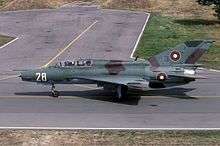
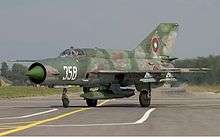


.jpg)
Since the early 2000s, Bulgaria has been trying actively to restructure its armed forces as a whole and a lot of attention has been placed on keeping the ageing Russian aircraft operational. Currently the attack and defence branches of the Bulgarian air force are composed of MiG-21s and MiG-29s. About 16 MiG-29 fighters have been modernized in order to meet NATO standards. In January 2011 the Bulgarian MoD issued a Request for Information (RFI) regarding the acquisition of 8 multi-role fighters. The main competitors are expected to be the Eurofighter Typhoon, Dassault Rafale, Saab JAS 39 Gripen, Mikoyan MiG-29 or MiG-35, Lockheed Martin F-16 and Boeing F/A-18 Super Hornet. On March 9, 2011 the Swedish Government submitted its response to the RFI containing 8 new Gripen C/D fighters. The Bulgarian MoD has extended the time limit for submittal of responses by two months due to the lack of responses from the other competitors.
In 2006 the Bulgarian government signed a contract with Alenia Aeronautica for the delivery of five C-27J Spartan transport aircraft in order to replace the older Soviet An-24 and An-26. The first Spartan arrived in 2007. Now, the contract has changed to the delivery of only 3 planes and final plane arrived on 31 March 2011.
Modern European transport helicopters were ordered and purchased in 2005 and until now 12 Eurocopter Cougar helicopters (8 transport and 4 CSAR) have arrived. For the Navy 3 Eurocopter Panther were ordered and have been delivered.
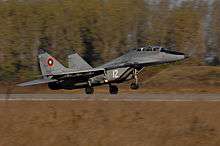
Branches of the air force include:
- Fighter aviation
- Fighter-bomber aviation
- Ground attack aviation
- Tactical reconnaissance aviation
- Transport aviation
- Missile aid defense troops
- Radio-technical troops
- Communications troops
- Logistics and medical troops.
Bulgaria is planning to reinforce the international forces in Afghanistan by sending two Mil Mi-17 transport helicopters to the country. As a result, a special fund was created that will provide money for the renovation of older Soviet-made equipment, which could then be used in Afghanistan.[8]
Structure
- Air Forces Command, Sofia
- Command, Control and Surveillance Base
- Headquarters
- Air Operations Center, Sofia
- 1st Control and Surveillance Zone, Sofia
- 2nd Control and Surveillance Zone,
- 3rd Control and Surveillance Zone, Bratovo
- CIS and Navigation Systems Squadron, Graf Ignatievo Air Base
- CIS and Navigation Systems Squadron, Krumovo Air Base
- CIS and Navigation Systems Squadron, Dolna Mitropoliya Air Base
- Air Force Meteorological Center
- Aviation Technical Base
- 3rd Air Base, Graf Ignatievo Air Base
- Headquarters and Headquarters Services
- 1st Fighter Squadron, operating 6x MiG-21
- 2nd Fighter Squadron, operating 12x MiG-29A, 3x MiG-29UB
- Air Training Group, Dolna Mitropoliya Air Base, operating 6x Pilatus PC-9 and 6x Aero L-39 Albatros
- Aircraft Operational Support Ground Squadron
- Maintenance and Aircraft Repair Squadron
- Maintenance and Missile Repair Squadron
- Airfield Technical Support and Supply Squadron
- 24th Air Base, Krumovo Air Base
- Headquarters and Headquarters Services
- 1st Attack Helicopter Squadron, operating 6x Mi-24
- 2nd Transport Helicopter Squadron, operating 8x Eurocopter Cougar TTH, 4x Eurocopter Cougar CSAR, 4x Mi-17
- Air Transport Group, Vrazhdebna Air Base, operating 3x C-27J, 1x Pilatus PC-12, 2x Let L-410 Turbolet, 1x An-30, 2x An-26, 1x An-2
- Helicopter Training Flight, operating 6x Bell 206
- (Combat) Search and Rescue Flight, a company of infantrymen and medics
- Aircraft Operational Support Ground Squadron
- Maintenance and Aircraft Repair Squadron
- Airfield Technical Support and Supply Squadron
- 22nd Forward Deployment Air Base, Bezmer Air Base
- Missile Air Defence Base, Sofia
- Headquarters
- Missile Air Defence Battalion (S300P)
- Missile Air Defence Battalion (S125 Neva)
- Missile Air Defence Battalion (S125 Neva)
- Missile Air Defence Battalion (S125 Neva)
- Mobile Missile Air Defence Battalion (2K12 Kub), Stara Zagora
- Missile Air Defence Shooting Range, Shabla
- Special Equipment Base
- Military Police Company of the Air Forces Command
- Air Forces Command Documentation Support Center
- Command, Control and Surveillance Base
A possible development of the Bezmer forward deployment airbase in the near future is the retirement of the Su-25, merging of the flying and operational support components into the 3rd Airbase in Graf Ignatievo, and possibly basing a UAV squadron in Bezmer. The airbase is a joint Bulgarian-US facility and it also houses the helicopter squadron of the Bulgarian Border Police, flying Agusta-Westland helicopters - one AW139 and two AW109 Power.
Air Bases


Active Air Bases:
- 3rd Air Base, Graf Ignatievo Air Base
- 12th Training Air Group, Dolna Mitropoliya Air Base
- 24th Air Base, Krumovo Air Base
- 16th Transport Air Group, Vrazhdebna Air Base (Military part of Sofia Airport)
- 22nd Forward Deployment Air Base, Bezmer Air Base
Closed Air Bases:
- 1st Fighter Air Base, Dobroslavtsi Air Base
- 2nd Fighter Air Base, Gabrovnitsa Air Base
- 5th Fighter Air Base, Ravnets Air Base
- 25th Fighter-Bomber Air Base, Cheshnegirovo Air Base
- 26th Fighter-Bomber Air Base, Dobrich Air Base
Aircraft Inventory
With the exception of the Navy's small helicopter fleet, the Air Force is responsible for all military aircraft in Bulgaria. The Air Force's inventory numbers around 137 aircraft, including 55–56 combat jets, but only the MiG-29s, about a dozen Su-25s and a few MiG-21s are flight worthy. The L-39ZA is only used for training. The condition of some of the Su-25Ks is bad, but the Air Force is capable of overhauling and repairing them. There are around 23–30 helicopters operated by the Bulgarian Air Force at the moment, including just one Mil Mi-24 attack helicopter. Aircraft of Western origin have only begun to enter the fleet, numbering 27 of the total in service.
Bulgaria signed a deal with Eurocopter worth 358 million euros for purchase of 12 AS 532 Eurocopter Cougar (4 of which are modified for CSAR) and 3 Eurocopter Panther AS 565. The country also agreed to the purchase of 5 C27J transports with Alenia of Italy, a deal worth some 210 million €. At the end, only 3 Spartan had been delivered.
The BuAf plans to retire most of its Soviet-era aircraft, keeping only the Mikoyan-Gurevich MiG-29 Fulcrum fleet which was modernized only recently, as well as its Mi-24 gunships and Su-25s. The MiG-21s in service where scheduled to be replaced with possible American or European aircraft, but the program has been dealt with by poor budget and the program is currently delayed. Due to poor budget conditions of Bulgaria, the older Soviet aircraft may stay in service for years longer. Now there are many challеnges-huge problems with parts for the MiG-29s. A few engines will be delivered till the end of 2016 after renewing in Poland. There are plans for purchasing brand new powerplants, but after Bulgaria has chosen the un-licensed WZL factories RSK MiG does not want to work anymore with the country. When MiG-21 was retired in December 2015 things became even harder and the air force desperately needs a new multirole fighter plane.
On November 11, 2016, the Bulgarian government signed a 21.8-million euro contract for 10 MiG-29 engines (four new and six repaired), with the first pair scheduled to arrive by April 2017. The deal would eventually bring the number of active service MiG-29 aircraft from 9 to 14, as Bulgaria also announced it was looking to overhaul the fleet and buy eight new or second-hand fighter jets during the coming year.[10]
Weapons inventory
-
 Kh-29ML air-to-ground missile (on Su-25 ground attack jets)
Kh-29ML air-to-ground missile (on Su-25 ground attack jets) -
 S-5 unguided rocket (on Su-25 and Mi-24 helicopters, manufactured locally)
S-5 unguided rocket (on Su-25 and Mi-24 helicopters, manufactured locally) -
 GSh-30-1 cannon
GSh-30-1 cannon -
 GSh-23 cannon
GSh-23 cannon -
 NR-30 cannon
NR-30 cannon -
 AA-2 Atoll short-range AA missile
AA-2 Atoll short-range AA missile -
 AA-8 Aphid short-range AA missile
AA-8 Aphid short-range AA missile -
 AA-10 Alamo medium-range AA missile
AA-10 Alamo medium-range AA missile -
 AA-11 Archer short-range AA missile
AA-11 Archer short-range AA missile - different types of free-falling bombs and machine guns
Ranks
| |
|
|
|
|
|
|
|
|
|
| |
| Звание | Генерал | Генерал-лейтенант | Генерал-майор | Бригаден генерал | Полковник | Подполковник | Майор | Капитан | Старши лейтенант | Лейтенант | Младши лейтенант |
| Title | General | General-lieutenant | General-major | Brigadier General | Colonel | Lieutenant Colonel | Major | Captain | Senior Lieutenant | Lieutenant | Junior Lieutenant |
| |
|
|
|
|
|
| |
| Звание | Офицерски кандидат | Старшина | Старши сержант | Сержант | Младши сержант | Ефрейтор | Редник |
| Title | Warrant Officer | Chief Petty Officer | Sergeant First Class | Staff Sergeant | Sergeant | Corporal | Private |
Notable facilities
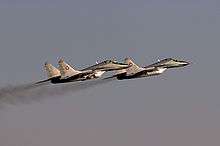
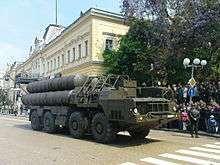
- 1st Fighter Air Base – Dobroslavtsi Air Base
- 2nd Fighter Air Base – Gabrovnitsa Air Base
- 3rd Fighter Air Base – Graf Ignatievo Air Base
- 4th Fighter Air Base – Uzundzhovo Air Base(later 21st Fighter-Bomber Air Base)
- 5th Fighter Air Base – Ravnets Air Base
- 6th Fighter Air Base – Balchik Air Base
- 11th Training Air Base – Shtraklevo Air Base
- 12th Training Air Base – Kamenets (now transferred to Dolna Mitropoliya)
- 16th Transport Air Base – Vrazhdebna Air Base (military area of Sofia Airport)
- 21st Fighter-Bomber Air Base – Uzundzhovo Air Base(formerly 4th FAB)
- 22nd Ground Attack Air Base – Bezmer Air Base (becoming a joint Bulgarian-American training facility)
- 23rd Attack Helicopters Air Base – Stara Zagora Air Base
- 24th Helicopter Air Base – Krumovo Air Base (military area of Plovdiv Airport)
- 25th Fighter-Bomber Air Base – Cheshnegirovo Air Base/ Sadovo
- 26th Reconnaissance Air Base – Dobrich Air Base
- Bozhurishte Airfield
- The city of Plovdiv used to house the headquarters of the Tactical Aviation Command and is still a place of significance as it houses a number of logistical and operational support units of the Bulgarian Air Force.
- The city of Bourgas is the place around which the 3rd Missile Air Defence Brigade of the Bulgarian Air Force is deployed.
- 63rd Independent Maritime Helicopter Air Base at Varna – Chaika, which houses the Independent Maritime Helicopter Squadron.
See also
- 28th Air Detachment
- Bulgaria
- Military of Bulgaria
- The Bulgarian Cosmonauts
- List of joint US-Bulgarian military bases
References
- 1 2 3 4 5 6 7 8 9 Nedialkov, D. "Air Power of the Kingdom of Bulgaria. Part I"
- 1 2 Rumen Kirilov, Ivan Borislavov, "The Bulgarian Aviation In the Chains of the Neuilly Peace Treaty", in: "Klub Krile Magazine", special, Vol. 11, 1999, "Air Group 2000" Publishing, Sofia, Bulgaria
- ↑ Green and Swanborough Air Enthusiast Thirty-nine, p. 63.
- ↑ Green and Swanborough Air Enthusiast Thirty-nine, pp. 64–65.
- ↑ Green and Swanborough Air Enthusiast Thirty-nine, p. 66.
- 1 2 Bateson Air Pictorial March 1972, p. 94.
- ↑ Bateson Air Pictorial April 1972, p. 141.
- ↑ Bulgaria to deploy helicopters in Afghanistan
- ↑ "Bulgaria sells ten Su-25s to Georgia"
- ↑ Bulgaria signs deal to buy 10 Russian engines for aging fleet (Reuters, November 11, 2016)
- Bateson, Richard P. "Bulgaria at War: Part 1: Rebirth of an Air Force". Air Pictorial., Vol. 34, No. 3, March 1972. pp. 88–94.
- Bateson, Richard P. "Bulgaria at War: Part 2: Into Battle". Air Pictorial., Vol. 34, No. 4, April 1972. pp. 140–143.
- Bateson, Richard P. "Bulgaria at War: Part 3: Under the Allied Onslaught; a change of sides". Air Pictorial., Vol. 34, No. 5, May 1972. pp. 177–179, 181.
- Green, William and Gordon Swanborough. "Balkan Interlude: The Bulgarian Air Arm In WWII". Air Enthusiast, Thirty-nine, May–August 1989. Bromley, UK:Tri-Service Press. ISSN 0143-5450. pp. 58–74.
- World Aircraft Information Files. Brightstar Publishing, London. File 327 Sheet 04
- Nedialkov, Dimitar. "Air Power of the Kingdom of Bulgaria. Part I", Fark OOD, Sofia, 2001. ISBN 9549669793 (bilingual: Bulgarian/English)
